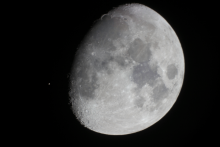Listen to today's episode of StarDate on the web the same day it airs in high-quality streaming audio without any extra ads or announcements. Choose a $8 one-month pass, or listen every day for a year for just $30.
You are here
Moon and Aldebaran
The surface of a star vibrates like a concert hall where a thousand orchestras are tuning up at once. By separating the different notes, astronomers can learn a great deal about the star. In the case of Aldebaran, the eye of the bull, it revealed that astronomers had been wrong about the star’s mass, which meant they’d been wrong about other things as well.
The vibrations are untangled through a technique known as asteroseismology. Giant cells of hot gas rise and fall through a star’s outer layers. Near the surface, that generates pressure waves. The waves ripple through the star, causing its surface to jiggle up and down a bit. Astronomers can measure those jiggles.
Different waves move through the star in different ways. Piecing together the waves reveals a lot about the star, and what’s happening deep inside it.
A few years ago, astronomers pieced together almost three decades of observations of Aldebaran. Among other things, they showed that estimates of Aldebaran’s weight were all wrong. Instead of 70 percent more massive than the Sun, it was only 16 percent heavier. And since a star’s mass determines how quickly it ages, that meant that Aldebaran was about six and a half billion years old — a billion and half years older than earlier estimates.
Look for Aldebaran near the Moon the next couple of mornings. The bright star is below the Moon at first light tomorrow, and to the right of the Moon on Sunday.
Script by Damond Benningfield




